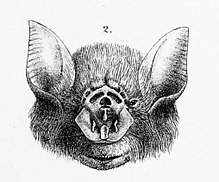Rhinonicteris
| Rhinonicteris | |
|---|---|

| |
| Scientific classification | |
| Domain: | Eukaryota |
| Kingdom: | Animalia |
| Phylum: | Chordata |
| Class: | Mammalia |
| Order: | Chiroptera |
| Family: | Rhinonycteridae |
| Genus: | Rhinonicteris Gray, 1847 |

| |
| Orange leaf-nosed bat range | |
Rhinonicteris is a genus of leaf-nosed microbats, represented by fossil taxa found at Riverleigh in Queensland and the extant species Rhinonicteris aurantia, which occurs in the north and west of the australian continent.
The genus was erected by Gray in 1847 to separate the species Rhinonicteris aurantia, nominating it as the type and only species.[1][2] The genus name published as Rhinonycteris Gray, J.E. 1866 has been regarded as a later correction by Gray, but this has also been determined to be an unjustified emendation.[3][4]
The genus is placed with the family Hipposideridae, the subject of taxonomic instability that has seen itself reduced in rank to a subfamily of Rhinolophidae.[5] A revision in 2014 reëlevated a subfamilial taxon as family Rhinonycteridae, which includes described and proposed fossil taxa:[6]
- family Rhinonycteridae. elevated by Foley, et al, 2014.[6]
- genus Rhinonicteris J.E. Gray, 1847
- species Rhinonicteris aurantia (J.E. Gray, 1845).
- Rhinonicteris aurantia (Pilbara form) recognised as an isolated group
- species Rhinonicteris tedfordi Hand, 1993. Fossil taxon.[7]
- species Rhinonicteris aurantia (J.E. Gray, 1845).
- genus Rhinonicteris J.E. Gray, 1847
References
- ^ Rhinonicteris Gray, J.E. 1847. Characters of six new genera of bats not hitherto distinguished. Proceedings of the Zoological Society of London 1847: 14-16 [publication date established from Sclater, P.L. 1893. List of the dates of receipt from the Printers of the sheets of the Society's 'Proceedings' from 1831 to 1859 inclusive. Proceedings of the Zoological Society of London 1893: 435–440 [438]] [16].
- ^ "Genus Rhinonicteris J.E. Gray, 1847". Australian Faunal Directory. Department of the Environment and Energy. Retrieved 29 January 2019.
- ^ Gray, John Edward (1866). "A revision of the genera of Rhinolophidae, or horseshoe bats". Proceedings of the Zoological Society of London. 1866: 81–83. ISSN 0370-2774.
- ^ "Species Rhinonicteris aurantia (J.E. Gray, 1845)". Australian Faunal Directory. Australian Government. Retrieved 31 December 2018.
- ^ Simmons, N.B. (2005). "Order Chiroptera". In Wilson, D.E.; Reeder, D.M (eds.). Mammal Species of the World: A Taxonomic and Geographic Reference (3rd ed.). Johns Hopkins University Press. p. 378. ISBN 978-0-8018-8221-0. OCLC 62265494.
- ^ a b Foley, Nicole M.; Thong, Vu Dinh; Soisook, Pipat; Goodman, Steven M.; Armstrong, Kyle N.; Jacobs, David S.; Puechmaille, Sébastien J.; Teeling, Emma C. (February 2015). "How and Why Overcome the Impediments to Resolution: Lessons from rhinolophid and hipposiderid Bats". Molecular Biology and Evolution. 32 (2): 313–333. doi:10.1093/molbev/msu329. PMC 4769323. PMID 25433366.
- ^ Hand, Suzanne J. (1993). "First skull of a species of Hipposideros (Brachipposideros) (Microchiroptera: Hipposideridae). from Australian Miocene sediments". Memoirs of the Queensland Museum. 33: 179–192. ISSN 0079-8835.
